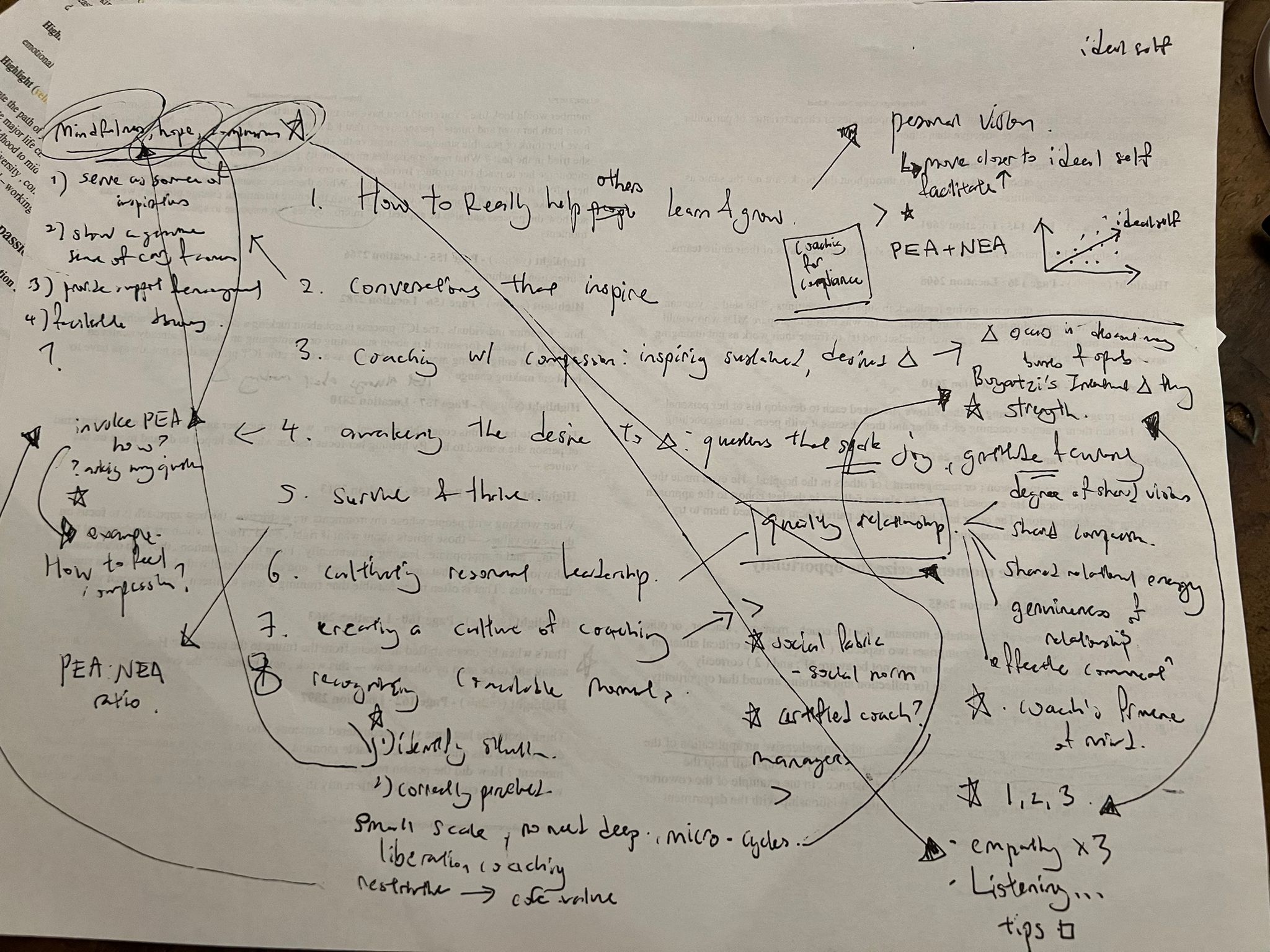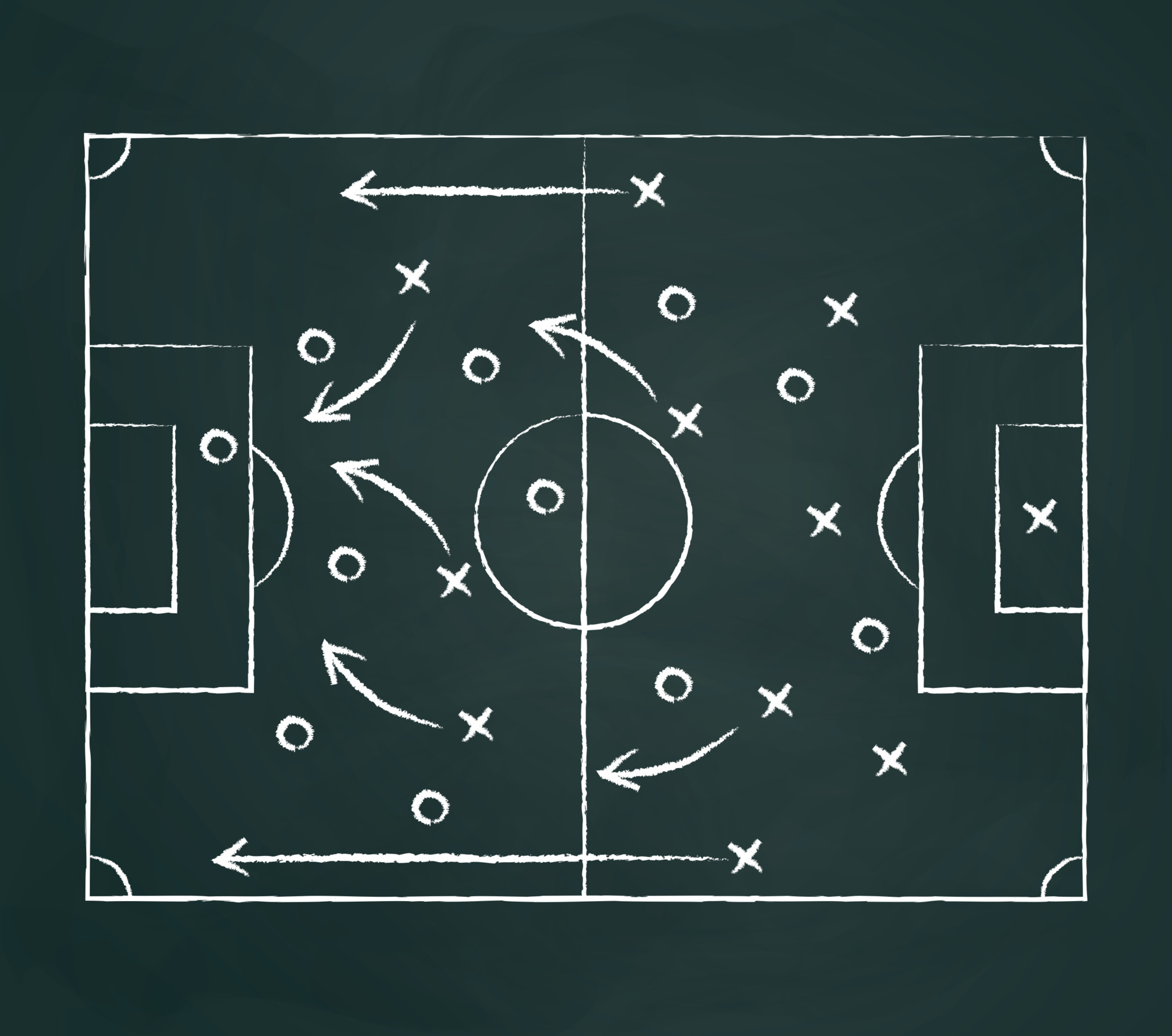My Coaching Notes: Coaching Process
By Ken Koon Wong in coaching upskill leadership notes compassion PEA NEA value
April 28, 2024
The coaching process unfolds through seven key domains: identifying the ideal vision, understanding the PEA, cultivating mindfulness, hope, and empathy, invoking PEA, fostering a quality relationship, embracing the coaching culture, and recognizing coachable moments. By focusing on these areas, you can build a long-lasting and mutually beneficial coaching relationship. The book “Helping People Change” offered so many great insights, it’s definitely worth reading! Here is my notes to future myself.
Coaching Process:
The coaching process hinges on creating a shared environment for the coach and coachee. This environment is characterized by a common understanding (shared mental model), a coaching mindset from both parties, and fostering a space built on empathy that facilitates growth. Building on our previous coaching framework, here’s an updated picture that incorporates these environmental aspects.
 Notice how we’re focusing on our next journey,
Notice how we’re focusing on our next journey, coaching process, via our coach (aka book:
Helping People Change: Coaching with Compassion for Lifelong Learning and Growth). Let’s dive in.
One Page Summary:
 The book was a treasure trove of insightful ideas and examples. Here’s how I interpreted its message and how it impacted my approach. Initially, I tried to create a structured, “if this then that” approach based on the book’s teachings. However, it became clear that this wasn’t the right fit. A breakthrough came when I started jotting down key takeaways that resonated with me. As I did, connections and patterns began to emerge organically. The most surprising discovery? There’s no single, rigid formula. Everything in the book seems to be interconnected! (See below for my messy notes.)
The book was a treasure trove of insightful ideas and examples. Here’s how I interpreted its message and how it impacted my approach. Initially, I tried to create a structured, “if this then that” approach based on the book’s teachings. However, it became clear that this wasn’t the right fit. A breakthrough came when I started jotting down key takeaways that resonated with me. As I did, connections and patterns began to emerge organically. The most surprising discovery? There’s no single, rigid formula. Everything in the book seems to be interconnected! (See below for my messy notes.)

Notice how there are so many arrows going from one point to another? Interconnectedness!
Objectives:
- Personal Vision -> Ideal Self
- PEA & NEA, Invoke PEA, PEA:NEA ratio
- Mindfulness, Hope, Compassion
- Invoke
- Quality Relationship
- Culture
- Recognizing A Coachable Moment
Disclaimer:
I’m not an expert in coaching. The main reason for these blogs is for me to write out my notes, thought processes, and further refine my skills. Even if this doesn’t happen, it allows me to revisit my notes years later and see if my future processes have changed or deviated from my original notes. It’s going to be both fun and exciting!
Personal Vision -> Ideal Self

From the book, an interesting discovery for me is that there are times when people have some serious problems they must resolve, but their research tells them that when the context is a gap or shortfall that needs addressing, the energy and effort needed to sustain change is typically absent. Conversely, when the context is a long-term dream or vision, peope draw energy from that vision and are able to sustain their effort to change even through difficult times.
PEA & NEA, Invoke PEA, PEA:NEA ratio

Positive Emotional Attractor (PEA):
Represents the ideal future self and the vision that motivates and excites the client. Associated with positive emotions like hope, passion, creativity, and fulfillment. Goals aligned with the PEA often focus on strengths, aspirations, and personal growth.
Negative Emotional Attractor (NEA):
Represents the negative future self or the vision that creates fear, anxiety, or a sense of stagnation. Associated with negative emotions like fear, shame, regret, and frustration. Goals stemming from the NEA might be driven by a need to avoid negative outcomes or maintain a certain standard.
Importance of PEA and NEA:
Recognizing both PEA and NEA is crucial for effective coaching. Focusing solely on the PEA might lead to unrealistic goals or a lack of action. Overemphasizing the NEA can create fear and hinder progress. A skilled coach helps clients explore both attractors and use them to achieve sustainable results.
PEA:NEA ratio:
By understanding the motivations behind both the PEA and NEA, the ideal ratio of PEA:NEA is 3 to 5 is to 1. Interesting, in their article The role of the positive emotional attractor in vision and shared vision: toward effective leadership, relationships, and engagement showed the 4 propositions to a successful organization.
Life is like a Roller Coaster
 As depicted above, it's the trend that we are interested. You win some, you lose some, that's life in general. Being grateful of the successes, and learn from the mistakes would be ideal. Quite often, and naturally, our emotions and memories gravitate towards the `red points`. How does one bounce/swing back to the baseline mood would depend on our emotional make up. As a coach, we can serve as the catalyst for equibilium.
As depicted above, it's the trend that we are interested. You win some, you lose some, that's life in general. Being grateful of the successes, and learn from the mistakes would be ideal. Quite often, and naturally, our emotions and memories gravitate towards the `red points`. How does one bounce/swing back to the baseline mood would depend on our emotional make up. As a coach, we can serve as the catalyst for equibilium.
Proposition 1: Visions must be based on an ideal self rather than an ought self in order to produce sustained and desired change.
Proposition 2: The NEA is detrimental to developing a vision based on the ideal self.
Proposition 3: In order to create a vision based on an ideal self a person must be in the PEA.
Proposition 4: Both PEA and NEA are required in order for an ideal self based vision to lead to sustained desired change; however, a person must spend significantly more time in the PEA than in the NEA.
Mindfulness, Hope, Compassion

As in the book, people who influences others most often:
- serve as a source of inspiration
- show a genuine sense of caring and concern
- provide support and encouragement
- facilitate the discovery and pursuit of the dreams and passions of the people they are coaching
One can only offer all of the above if they are mindful of the situation, the relationship, the coachee’s emotions. One would also need to possess the ability to serve as a vessel for cultivating hope, encouragement, as a safe psychological space to dream and to make dream come true. Lastly, from the beginning to the end, driven by genuine compassionate energy that perculates all spaces and states, to make all these 3 powerhouses (mindfulness, hope, compassion) a norm and safe place for development of coachee’s ideal self.
An interesting framework/questions/strategy from the book, during this exercise, to separate the path of coachee’s life into distinct stages, the approximate time frames that denote major changes in life. These would be stage 1: childhood to mid-adolescence (~0-14 years), stage 2: high school (~15-18 years), stage 3: university/graduate school/post-graduate (~19-24 years), stage 4: early career (~25-35 years). Using these major transitions in life, bring out the coachee’s achievement and strength of each transitions to assess coachee’s very own life lessons. How did they overcome hardship, how did they achieve a dream, who inspired them, who supported them, what are they most grateful of during these transitions? These are great exercises to retrospectively investigate the driving force of the coachee using past encounters.
Invoke

How does a coach invoke the PEA for optimal growth? Sometimes the people who are trying to help them will not succeed in invoking PEA in a coachee. Asking the wrong question may arouse a coachee’s NEA, making the coaching process challenging. The book gave a very cool and popular example of survivorship bias (a subset of selection bias) in statistics.
During World War II, a statistician named Abraham Wald challenged conventional thinking to improve bomber survival rates. Examining damaged aircraft returning from missions, the focus was on reinforcing areas that showed the most bullet holes. However, Wald recognized a hidden bias: these planes were lucky enough to make it back.
Wrong question ❌ : “What parts of the planes coming back need more armor based on the bullet holes?”
Right question ✅ : “Where are all the planes that didn’t make it back? Maybe those bullet holes tell the real story.”
Wald’s ingenious concept was survivorship bias. He realized that the crucial data was missing from planes shot down – the ones with potentially fatal damage in unscathed areas on returning aircraft. Therefore, Wald proposed reinforcing these seemingly unimportant areas, as they were likely the critical points for bringing down bombers. This approach, based on the absence of damage rather than its presence, proved highly effective in minimizing bomber losses.
One example from the book resonated with me. They gave an example of a teacher who asked for her students’ response to the satement “I wish my teacher knew”. I felt that is a very powerful question. It gave the coachee the authority and power to choose and prioritize what ONE thing I wish someone who know about me, something so important to me that I would like the world to know?
This question, I feel, can be reframed for people in leadership roles. E.g., “What one thing you wish your supervisor/manager/program director/chair knew about you?”.
Reflection: Want to conduct a thought experiment? Ask yourself that very question. What will your response be?
Another way to help a coachee to invoke PEA is to help a person feel hopeful about the future. One can do this by asking about his/her/their dreams and vision, questions that spark joy, gratitude, and curiosity. Reflecting onthe people who have helped us in life invokes gratitude and the PEA. Being in a loving relationship is another great way to sustain compassion in our daily lives.
Boyatzis Intentional Change Theory
The book mentioned this but what is it? Intentional Change Theory (ICT), formulated by Richard Boyatzis in 2006, is a psychological framework designed to help individuals and organizations achieve and maintain positive changes. The model outlines a cyclical, five-stage process of change: (1) identifying an ideal self, (2) assessing one’s current self, (3) creating a learning agenda, (4) trying out new behaviors, thoughts, and emotions, and (5) practicing these new behaviors to solidify them as part of one’s identity. A key element of ICT is the role of positive emotional attractors (PEAs) such as hope, optimism, and compassion, which drive change, versus negative emotional attractors (NEAs) like fear, stress, and anxiety, which can obstruct it.
Interestingly, and quite true, the book mentioned that behavioral change tends to occur in discontinuous bursts or spurts, which Boyatzis described it as discovery. A compassionate coach can help coachees see how to make their change efforts more successful by first recognizing and leveraging their strengths, only then should they attempt to address any opportunities for improvement, prioritizing on those that assist coachees make the most progress toward their ideal vision.
So, how do we invoke PEA on another person?
- Ask the right question! This is probably the hardest skill
- Ask questions that spark joy
- Reflect on people who have helped us, practice gratitude and compassion
- Invite positive curiosity, e.g., so what if you do this? how would that look/feel like?
- Iterative, persistent effort in coaching with compassion, knowing change tends to occur in discountinuous bursts or spurts.
Quality Relationship

The 4 Main Ingredients:
According to the book, the key to quality coach-coachee relationship is due to 4 ingredients:
- Degree of shared vision
- Shared compassion
- Shared relational energy
- Genuineness of relationship
- Effective communication
These make sense! Even the ingredients / factors themselves are difficult to exist without one another to create a quality relationship. Let’s conduct a playful thought experiment to consolidate the feeling of these factors. Imagine we are in a “Zombie” apocalypse, and you are traveling and surviving with another person. In order to have synergism, both will need to know where they’re heading. Do you know where you want to go? Do you know what is the immediate goal and long term goal? Do you know the other survivor’s goal? Are they in synced? That’s shared vision. Now imagine both of you are traveling by foot through the woods, you have to watch out for each other. When you are at the camp site, who stays up for the look out? You take turns, right? If your partner is sick, you would take extra shifts for the look out! Why? Shared compassion and relational energy. I’m sure your partner would do the same. Other than shared compassion and relational energy, it’s about survivorship, it’s mutually beneficial! And of course, with this long journey, having 2 humans spending 24/7 together, there is going to be some quibble. Without being able to express oneselves honestly and genuinely, the relationships will not be able to flourish. Lastly, being direct all the time may not be effective if that is not the style of the recipient of th conversation. There is usually a good time and place for that, or there is a way / style of communication that the recipient would prefer, to be more receptive.
Your Frame Of Mind is Important For The Coachee
The coach’s frame of mind is important factor in effective coaching. If we are internally off, do not expect the coaching session to be optimal. If that is the case, how can we re-center ourselves before a coaching session then? Does one have a pre-coach routine? That is a very interesting question. I have not come across anything yet, maybe it is something I need to develop for myself or it might end up being in other books. Side note, this is interesting thought process, it is as if going through a pre-coaching routine would be able to recalibrate oneself, or is it something that we have to do everyday regardless of whether there is a coaching session in order to make ourselves more mindful and aware of our current state / frame of mind? More to come on this, we’ll find out!
Cornerstone of Coaching 1,2,3
- Believe the individual change is a process, not an event
- Consider your approach to coaching as a chance to mine for gold, not dig for dirt
- Consider that the agenda for the conversation should come from the person being coached.
Wow, these are gems! I can imagine myself feeling frustrated umpteen times whenever a conversation did not go my way. The first advice is a great reminder that each conversation is an encounter, whether the outcome turns out great or not, it may still hve influence on the other person, or even ourselves for that matter. The second advice is fantastic! What I would be more mindful moving forward is that my internal dialog / signal of “omg” would need to go through this Gate of Gold, how can I mine gold from this quary? Almost like CNOT gate in quantum computing.
Listening tips
From the book, the authors offered some insightful ideas to improve or develop listening skills. The authors divided listening skills into 3 stages:
- Stage 1: Connection level
- Listening to others and decide what those words mean to us
- Stage 2: Focused level
- As the name suggested, full attention to the coachee, demonstrating empathy and intuition to deeply understand and connect with those whom we interact
- Stage 3: Global level
- “Listening” involving senses beyond words, what we hear, what is not being said in addition to what is being shared.
Next, the overall proportion of listening and talking ought to be 80 and 20%, while keeping in mind of what the authors refer to as WAIT : Why Am I Talking?, which I thought is quite clever.
Culture

Coaching process so far has been about developing coaches who then go on to develop others. But what if there was a way to make coaching itself a normal part of how everyone in the company interacts? Imagine a company where coaching wasn't just a fancy program, but how people naturally talked to each other. Leaders wouldn’t just give orders, they’d ask questions that make people think about their goals. Coworkers would give each other feedback to help them improve, not just point out mistakes. This kind of open and supportive environment would make it easier for everyone to learn and grow from each other. Feeling safe to make mistakes is another big part of a coaching culture. People wouldn’t be afraid to mess up because everyone would see it as a chance to learn. This would make it easier for people to ask for help and offer it to others, knowing they could give and receive honest feedback without getting judged. Learning wouldn’t just happen in special training sessions anymore. Coaching conversations would become a normal part of the day, like brainstorming solutions during meetings or chatting about a project in the hallway. By integrating coaching into everyday work, companies could make sure everyone is constantly learning and growing.
Developing Your Own Personal Board of Directors. Not only will this exercise help people increase awareness of their key relationships and sources of support, but it also provides them with a ready-made list of people with whom they can check their progress.
This is an excellent idea! Not only can one can an assessment of how other people measure your progress, but it is also a great opportunity to gauge self awareness and calibrate it with how others see us. We often times either think we’re doing a great or horrible job, but do not actually know how others think of our doing.
Organizational adoption of peer coaching, development of coaching skills in leadership roles may not be a norm wherever we work, however, if you develop your own coaching skills, you can also influence others by having one conversation at a time.
Recognizing A Coachable Moment

Other than having a fantastic listening skill, creating a safe and trustworthy environment, ask good questions, a coach needs to hone the skill in recognizing a coachable moment. He/she/they would have to identify a situation whether he/she/they correctly perceived a coachable moment. A funny example, not sure if it was from this book or another one, was that when a person comes to ask you for direction to the restroom, you don’t pause and ask “and what else?” or “that sounds important to you”, that is just plain silly, though this would be a great one for a “coaching” parody. Sometimes, people just want you to say the answer, and if that is the case, say the answer! It’s not a coachable moment. Soemtimes, people just want you to listen, in that case, turn on your superpower listening skill, and tell yourself W.A.I.T - why am I talking?
Get Unstuck
What if we recognize that there may still be a coachable moment in restrictive situation? What tools should we use? The authors suggested a few methods:
- break into small scales, e.g., micro-cycles
- ask for ideal relationship
- reflect historical interaction that leads to current issue
- think about possible strategies to improve situation? what was tried? what new things to try?
- encourage them to reach out to others who might be able to support effort in improving relationship
It is also interesting to note that not everyone’s ideal vision is about making changes, especially if the ideal self has already been achieved. Recognizing that will also be helpful in guiding how to coaching conversation goes.
Opportunities for Improvement/Practice:
- Practice, practice, practice
- Pick one domain to practice per day
- Invoke a PEA on a person per day
- Develop a self pre-coaching checklist/routine to assess and recalibrate my own frame of mind
- Ask a get unstuck question whenever a restrictive situation arises
- Practice recognizing a coachable moment
Final Thoughts:
- Helping People Change: Coaching with Compassion for Lifelong Learning and Growth is a fantastic book! It’s filled with great insights and stories. This coaching note of mine definitely does not do justice to the extensive wisdom provided by the book itself, I encourage you to read it. These are my interpretation of the book, it may not reflect what was truly conveyed. If you see any errors, please feel free to reach out!
Lessons Learnt:
- Learnt about PEA and NEA
- If one is in serious problem they must resolve, they often lack energy and effort needed to sustain change. However, when context is a long-term dream or vision, people draw energy from it even through difficult times.
- PEA:NEA ratio ranges from 3:1 to 5:1
- Iterative, persistent effort in coaching with compassion, knowing change tends to occur in discountinuous bursts or spurts
- Believe the individual change is a process, not an event; Consider your approach to coaching as a chance to mine for gold, not dig for dirt
- Listeni 80% Talk 20%; WAIT!
Other coaching notes:
If you like this article:
- please feel free to send me a comment or visit my other blogs
- please feel free to follow me on twitter, GitHub or Mastodon
- if you would like collaborate please feel free to contact me
- Posted on:
- April 28, 2024
- Length:
- 17 minute read, 3486 words
- Categories:
- coaching upskill leadership notes compassion PEA NEA value
- Tags:
- coaching upskill leadership notes compassion PEA NEA value